Next time you visit
a yarn shop, take a good look at the
wool yarns. Besides color and weight,
you'll notice another big difference
among them -- the way the yarns are
plied, the way the individual plies
of wool are twisted around each other
to make the final yarn. There are
four main ways of plying that are
done nowadays -- conventional, single,
cabled and multi-strand - and these
can cause some noticeable differences
in the way that stockinette stitch
will appear in your knitting.
When you use these
four kinds of yarns, you likely don't
think about their construction in
such detail. Isn't all that matters
that your knitting looks fine and
you've gotten the correct gauge?
Maybe not. The way
a yarn is plied can cause it to lie
differently after it's knit into a
fabric. This especially shows up in
stockinette stitches, where you see
the two halves of the V that form
each stitch on the right side of the
piece.
Have a look at the
following photos to see what's going
on. (Note -- the photos are been enlarged
to show more detail).
Conventionally
Plied yarns
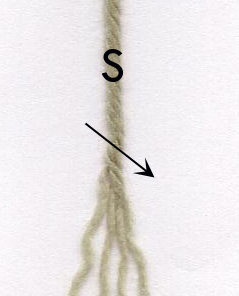 |
These
are the workhorses of wool yarns,
and have been spun for decades.
Most often you'll see four plies
of yarn twisted around each
other, like in the Debbie Bliss
Merino Aran shown at left.
Each ply is
called a 'single' because it
can't be broken down into more
strands; if you try pulling
one of the singles apart, you
get loose fiber. You can also
find yarns of only two or three
plies spun like this.
The final
yarn is twisted in the 'S' direction.
What this means is if you overlay
the letter 'S' over the yarn
strand, you can see that the
middle bar of the letter mimics
the direction of the final twist.
This direction is also pointed
out by the arrow. |
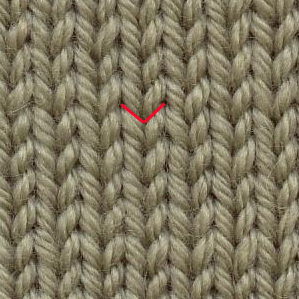 |
Stockinette
stitch with 4-ply yarn
The two halves
of each knit stitch are slanted
at nearly the same angle, and
each side of the stitch is almost
the same width. |
| Singles Yarns |
|
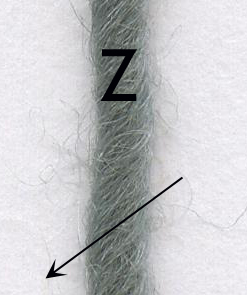 |
Sometimes
a yarn consists of one big single.
A good example is Brown Sheep's
Lamb's Pride Worsted, in which
many fibers are twisted around
each other to make one big ply.
Untwist the yarn and it's easy
to see all the loose fibers. The
only twist in the yarn is in the
'Z' direction. |
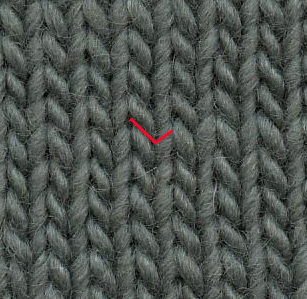 |
When
knitted up, it looks as if the
left side of each stitch is
twice as wide as the right side
and tilted at a different angle.
The right-side stitches appear
to be forming one continuous
vertical column.
There's nothing happening wrong
with the knitting; this is simply
how the yarn wants to lie, so
there will be no stress or bias
in the fabric. |
| Cabled yarns |
|
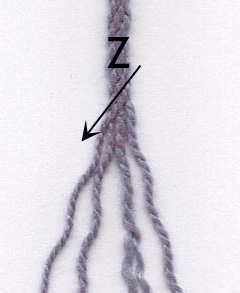 |
You
can take conventionally S-plied
yarns, and make a thicker yarn
out of them by doing a one more
twisting in the Z direction.
This is how a cabled yarn is
made; the final yarn has the
look of a cabled cord. All this
twisting results in a firmly
spun yarn. Adrianne Vittadini's
'Trina' is an example of this.
The final
yarn, which has its twist in
the Z direction, consists of
4 strands. Each strand is made
from 2 singles twisted around
each other. In the photo, the
third strand has been untwisted,
to show the loose fibers from
the two singles. |
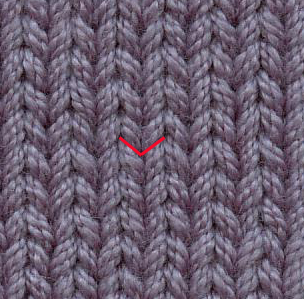 |
In the final yarn, you can
see some of the little twists
from each of the four strands,
which gives this yarn its distinctive
'cabled' look. And with a cabled
yarn, stockinette stitch looks
rather distinctive too. Both
halves of each knit stitch are
equal in width, and tilted to
the same degree.
However, you can make out the
little twistings within each
of the four strands, which gives
the fabric a slightly textured
look. |
| Multi-strand
Yarns |
|
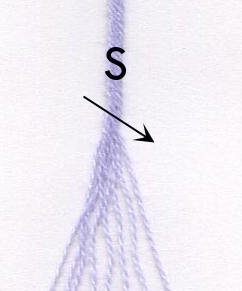 |
In the past
10 years or so, these yarns
have become more and more available.
They are called a number of
different names -- multi-strand,
multiple stranded, multi-ply,
many-plied, Merino S twisted,
and S-on-S multi-strand. Occasionally
they are called 'cabled' yarns,
but that's confusing with the
real cabled yarns shown above.
Plus, these multi-strand yarns
are made in a completely different
way.
Aurora 8 yarn
from Karabella is a multi-strand
yarn. The final yarn is made
from 8 thin 2-ply strands; hence
the number '8' in the name.
The 8 strands are twisted around
each other again in the S direction.
It may appear
that the final yarn is tightly
twisted, but it's not. It's
just the way the eight thin
strands want to lie next to
each other. If you untwist the
yarn, you can see that it's
not overspun. In fact, the yarn
feels quite soft and flexible,
and has good elasticity.
|
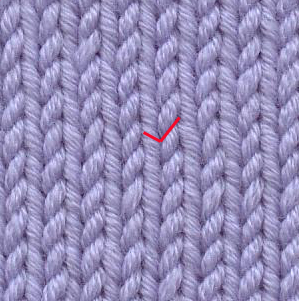 |
When
knitted up, these yarns have their
own unique look. The right side
of each stitch is nearly twice
as wide as the left side, and
tilted at a different angle. It
almost looks like the left sides
of the stitches are forming one
continuous vertical column. |
Why would a mill
go to the trouble of spinning thin
little 2-ply strands, if they are
just going to twist a bunch of them
together to make a thicker hand knitting
yarn? At first glance, it seems like
a lot of effort to go through.
Most of these yarns
are spun in Italy, and that's the
big reason why this multi-strand business
is done. A spinning mill can make
the thin 2-ply yarns for commercial
knitwear. The spinning mill can also
make hand knitting products by simply
twisting several of these 2-ply yarns
around each other, then skeining off
these thicker yarns into 50- or 100-gram
balls.
A spinning mill
covers a lot of bases by doing things
this way. First, the mill spins and
dyes the thin 2-ply yarns for commercial
knitwear. Then the mill can take four,
six, eight or ten of the thin 2-ply
yarns, and twist them together to
make, respectively, fingering weight,
DK weight, heavy worsted and bulky
weight yarns.
Not a bad way to
keep commercial and hand knitting
customers happy and well fed.
The bottom line
in all this is that there's nothing
wrong with your knitting, and nothing
wrong with the yarns. They aren't
poorly made, over-twisted or under-twisted
as people sometimes think. And you
don't need to wrap your yarn differently
to try and get rid of the slants in
the stitches.
So the next time
you go to your LYS, take a good look
at the wool yarns. Appreciate the
differences and knit away, now that
you know the appearance of your knitting
is exactly what it should be.

